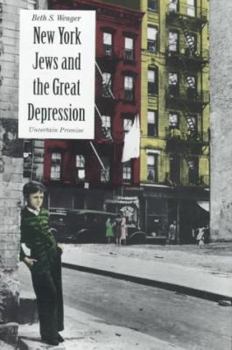New York Jews and the Great Depression: Uncertain Promise
(Part of the Modern Jewish History Series)
Select Format
Select Condition 
Book Overview
Chronicling the experience of New York City's Jewish families during the Great Depression, this work tells the story of a generation of immigrants and their children as they faced an uncertain future... This description may be from another edition of this product.
Format:Hardcover
Language:English
ISBN:0300062656
ISBN13:9780300062656
Release Date:December 1996
Publisher:Yale University Press
Length:288 Pages
Weight:1.42 lbs.
Dimensions:1.1" x 6.4" x 9.5"
Customer Reviews
1 rating
thorough and interesting
Published by Thriftbooks.com User , 20 years ago
Most of the editorial reviews are self-explanatory - a few things that surprised me: 1. The hardship that the Great Depression caused for synagogues and other Jewish institutions; I have always taken the financial stability of Jewish institutions for granted, but evidently Jews in the 1930s did not have this luxury. 2. That concerns over assimilation are nothing new. In 1929, almost 80% of NYC Jewish children received no religious training or Hebrew instruction (p. 184). 3. Where Jews lived (see p. 82 for table). I had always known that some once-Jewish neighborhoods have lost most of their Jewish population (mostly notably in the Bronx). But I did not know about similarities between then and now: for example, the Upper West Side, then as now, was heavily Jewish- and ditto for Borough Park (though the latter area was less homogenously Orthodox in the 30s than today). Other areas were virtually Jew-free in the 30s (Greenwich Village, Park Slope, Brooklyn Heights) and may actually be more Jewish today, as gentrification has brought in Jewish professionals. Similarly, the Jewish presence in Queens was minimal in the 30s, but is far larger today- I was astonished to learn, for instance, that Forest Hills was less than 10% Jewish in 1932.





